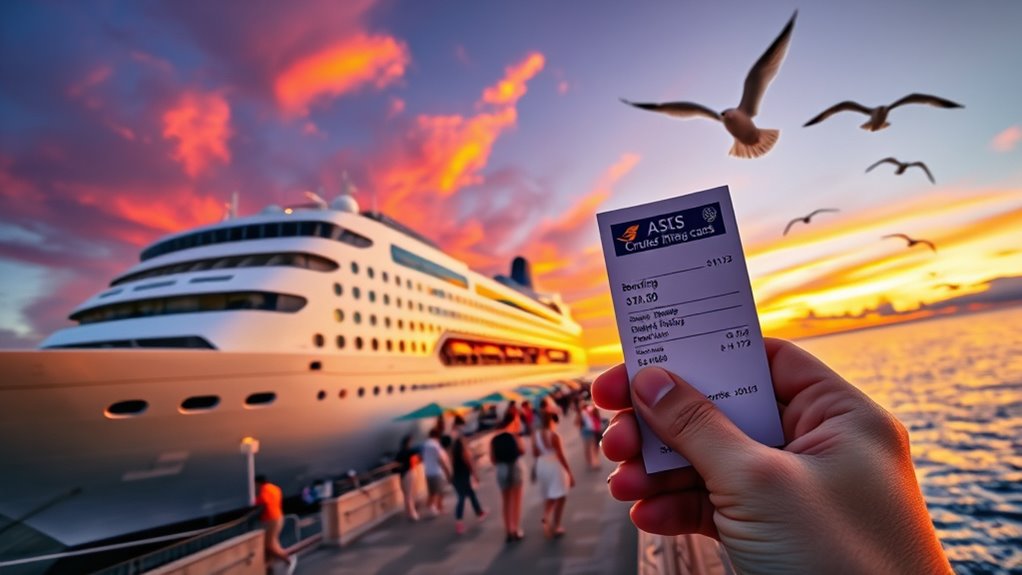A cruise’s true cost goes beyond the initial fare you see online. Expect to pay for taxes, port fees, drinks, specialty dining, excursions, and onboard activities that can add hundreds or even thousands more. Upgrading cabins or accessing private areas also boosts expenses. If you’re traveling solo or with family, costs vary further. To understand the full picture and budget confidently, there’s more to uncover about each element involved.
Key Takeaways
- The base fare covers accommodations and basic onboard amenities but excludes extras like drinks, excursions, specialty dining, and gratuities.
- Additional costs such as port taxes, government fees, and shore excursions can add hundreds to the total trip price.
- Upgrading to suites or private enclaves significantly increases costs, sometimes by thousands per week.
- Onboard expenses for beverages, activities, Wi-Fi, and shopping often surpass the initial fare if not budgeted for.
- Pre- and post-cruise expenses, including flights, hotels, and gratuities, also impact the overall cost of a cruise vacation.
Understanding the Base Fare and Its Inclusions
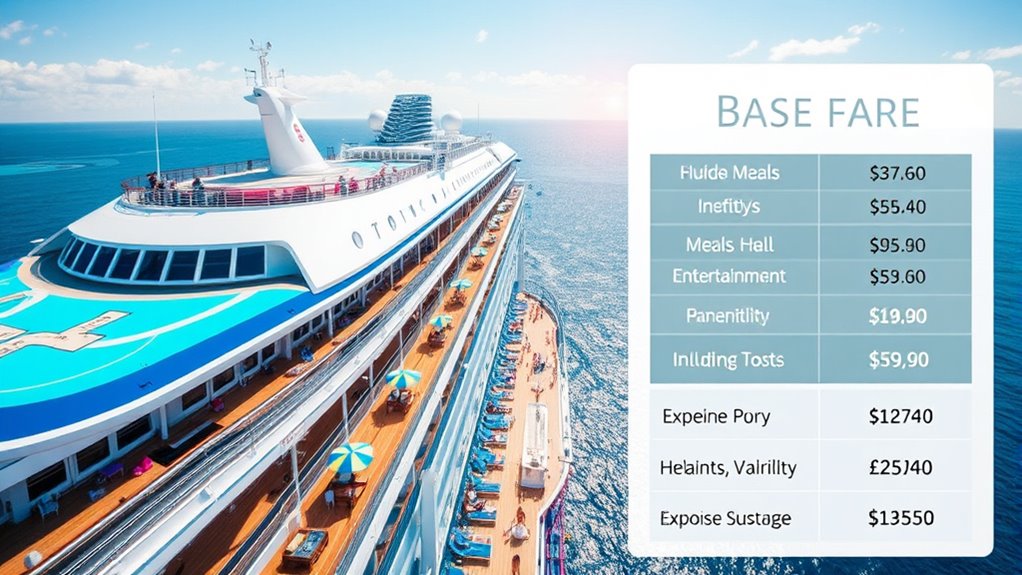
Have you wondered what exactly is included in the cruise’s base fare? The base fare covers your accommodation, most meals, onboard entertainment, and port transportation, giving you a solid foundation for your cruise costs. It’s usually calculated as a per night rate, with inside cabins starting around $50 and balcony or suite cabins costing $200 or more. The cruise fare also includes standard onboard services, but it excludes extras like specialty dining, drinks, excursions, and gratuities. Additional fees, such as port taxes, are often not included in the initial fare and can add hundreds to your total. Booking perks like onboard credits or upgrades may come with early reservations, but the core of your cruise’s price is primarily for accommodation charges and basic amenities.
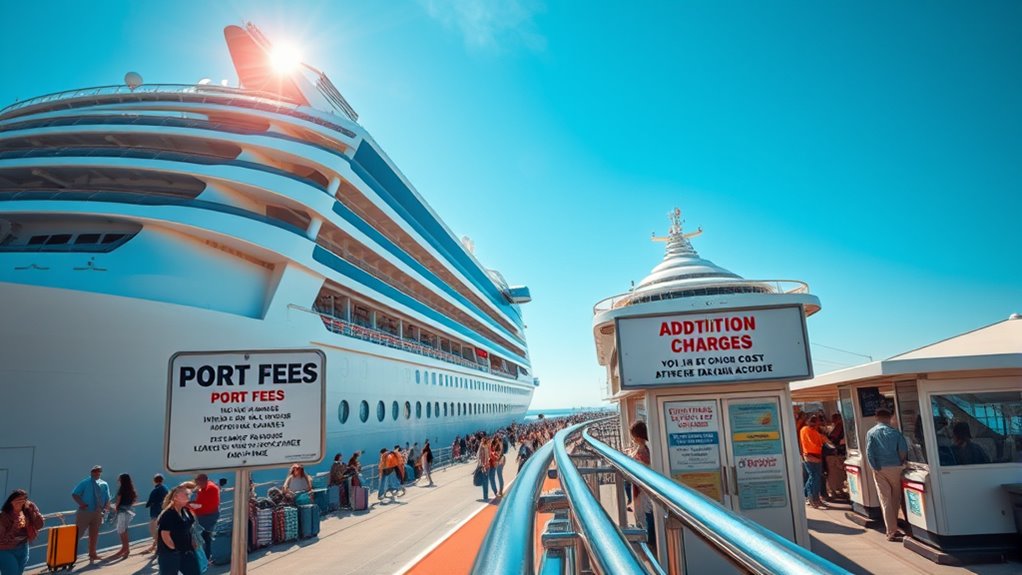
When planning your cruise, keep in mind that taxes and port fees can add $100 to $200 per person, often not included in the initial fare. Some fares cover these costs, but many require extra payment at booking or onboard. Additionally, expenses like shuttle rides or taxis at ports can further increase your overall trip costs.
Mandatory Port Charges
Did you know that mandatory port charges and taxes can add between $100 and $200 per person to your cruise costs? These port charges, which are non-negotiable, are included in your cruise fare or listed separately, so it’s vital to check. They cover port fees for docking, local government taxes, and sometimes environmental charges, depending on your itinerary and destination. Additional costs for government-imposed taxes may also be added, increasing your overall expense. These charges are unavoidable, and they substantially impact your total budget. Whether included in the fare or added later, understanding these fees helps you better estimate your trip’s true cost and avoid surprises. Always review your booking details to make sure you’re aware of all mandatory port charges and taxes before finalizing your cruise.
Hidden Tax Fees
Hidden tax fees are a significant factor often overlooked when estimating the true cost of a cruise. These include taxes, port fees, and government charges that can add $100 to $200 or more per person. Many cruise fares exclude these costs, which may be paid at booking or onboard, considerably increasing your total expenses. Embarkation port charges, security fees, and environmental surcharges are common additional costs that can double the advertised cruise fare. It’s vital to verify whether port taxes and fees are included in your initial price to avoid surprises. Understanding these fees can help you better plan your budget and avoid unexpected expenses. These hidden fees, combined with onboard expenses, can substantially raise the overall cost, making it imperative to factor them into your budget when planning your cruise. The cost of additional fees can vary depending on the cruise line and itinerary, further influencing the overall expense. Additionally, being aware of indoor gardening options like waterless planters can help you save on maintenance costs during your travels.
Additional Onboard Costs: Drinks, Dining, and Activities
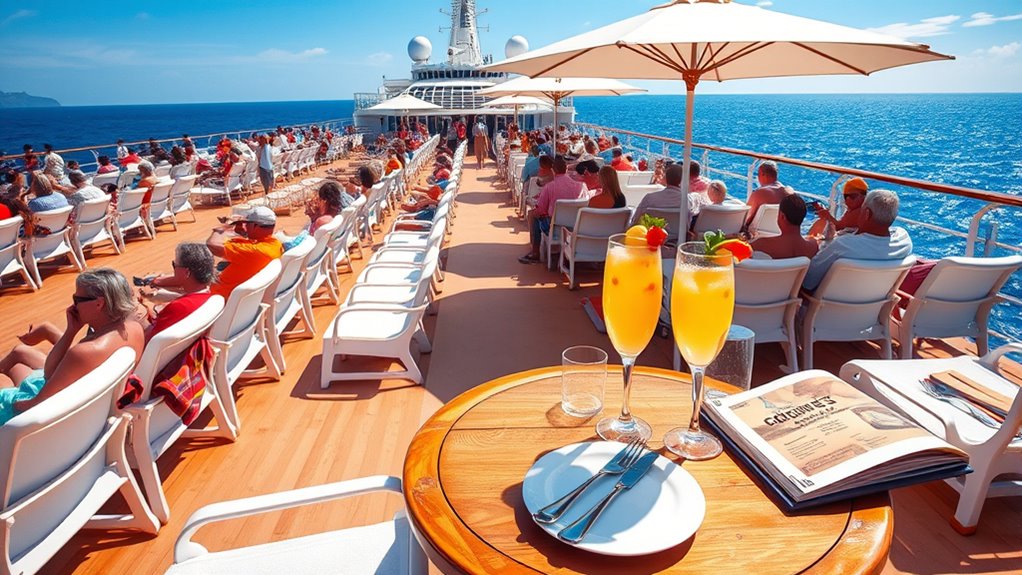
Onboard costs for drinks, dining, and activities can quickly add up beyond the base fare. While complimentary water, coffee, and juices are usually included, specialty beverages like cocktails, wine, and premium drinks cost $5 to $12 each unless you purchase a beverage package, which can range from $50 to over $100 daily. Specialty dining venues charge between $15 and $60 per person, with some upscale options exceeding $100. Onboard activities, including spa treatments, fitness classes, and shore excursions, often cost $50 to $150 per session. Photos taken onboard typically cost $20 or more, and Wi-Fi can range from $10 to $50 daily. Remember to factor in gratuity, which often isn’t included in the initial price, when estimating your onboard costs. Additionally, understanding cybersecurity measures can help protect your personal information during online transactions and communications on the ship. Being aware of financial security practices can help prevent potential issues with online payments and data breaches. To avoid unexpected expenses, it’s helpful to review the cruise line’s policies on additional charges and budget accordingly before setting sail. Implementing Quality Assurance practices can also ensure your onboard experience remains smooth and enjoyable by addressing any service issues promptly.
Shore Excursions and Off-Ship Shopping Expenses

Shore excursions and off-ship shopping can considerably impact your cruise budget, with costs ranging from $35 to over $300 per person depending on the activity and destination. You can save by booking private tours through platforms like Viator or Tripadvisor, which often cost less than cruise line offerings. To keep expenses low, explore local markets for souvenir shopping and port activities, as these are usually more affordable than onboard shops. Consider engaging in independent activities or self-guided tours, which offer personalized experiences and help reduce port costs. Waiting for end-of-cruise sales can also lead to excursion savings on jewelry, clothing, and duty-free liquor. Being strategic with port shopping and port costs ensures your off-ship expenses stay within your budget. Additionally, understanding the benefits of somatic therapy can help travelers manage stress and enhance their overall cruise experience. Incorporating local currency exchange knowledge can further optimize your spending and prevent overspending during port visits. Furthermore, being aware of juice cleanse and detox options available in port areas might provide healthy alternatives for wellness-conscious travelers seeking to balance relaxation with health benefits. Planning ahead for off-ship activities allows you to compare prices and select options that fit your financial plan, and researching leadership skills can help you negotiate better deals and navigate unfamiliar markets more effectively.
Upgrades, Suites, and Private Experiences
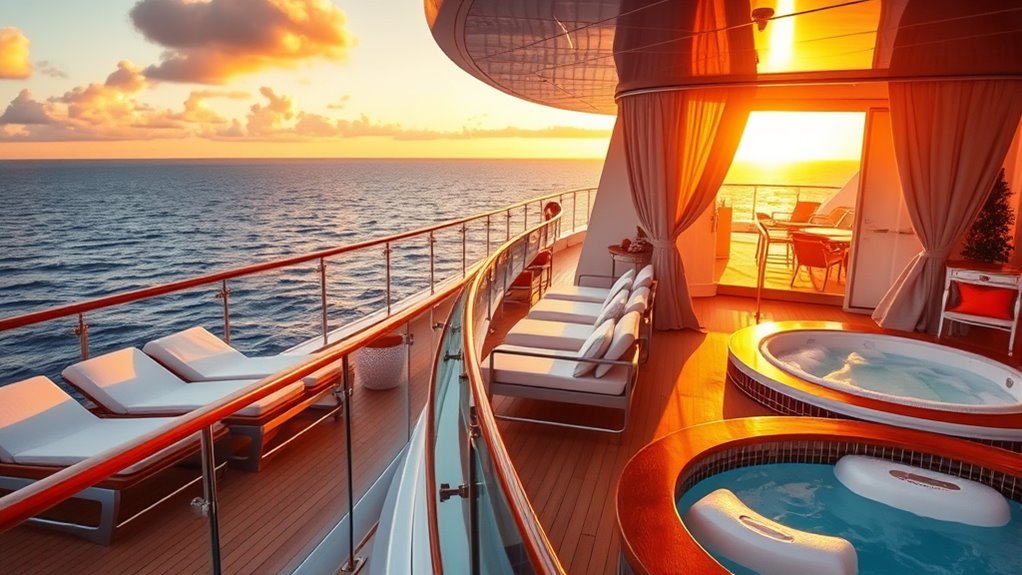
Upgrading to a suite or adding private experiences can substantially boost your cruise costs, but they also offer luxury perks like exclusive lounges and personalized service. Suites and private enclaves, such as MSC Yacht Club or The Haven, come with amenities that enhance your stay but come at a premium. Consider your budget carefully, as these upgrades and private retreats often range from a few hundred to several thousand dollars for the week. Additionally, the availability of luxury cruise offerings has grown to cater to affluent travelers seeking personalized and high-end experiences. These private experiences often include tailored excursions, dedicated concierge services, and access to secluded areas onboard to elevate your cruise adventure.
Suite Amenities and Perks
Choosing a suite for your cruise can considerably elevate your experience, offering a range of exclusive amenities and perks. These suite inclusions often include private enclave access, luxury accommodations, and enhanced onboard privileges. Upgrading to a suite adds suite perks such as priority boardings, dedicated concierge services, and access to exclusive areas. The suite costs reflect these benefits but provide a markedly upgraded cruise experience. Additionally, many suites feature luxury accommodations and personalized services that cater to your specific preferences. Some key suite benefits include: 1. Private enclave with VIP amenities 2. Inclusive beverage packages and Wi-Fi 3. Additional onboard credits and shore excursion discounts
These suite amenities and perks make your cruise more comfortable and luxurious, offering exclusive access and suite upgrades that transform a standard voyage into a private retreat with superior suite benefits.
Private Retreats and Enclaves
Experience true exclusivity onboard by opting for private retreats and enclaves like MSC Yacht Club, The Haven by Norwegian, or The Retreat by Celebrity. These private enclaves offer suite upgrades that grant access to luxury amenities, including private pools, VIP check-in, and dedicated concierge services. With onboard perks like exclusive access to private lounges and dining, you enjoy a more personalized experience. Many packages include premium offerings such as shore excursions, complimentary beverages, and onboard credits, adding value to your stay. Suite costs can be considerably higher—often 2-4 times more than standard cabins—but they include upgraded furnishings, larger spaces, and balconies. Opting for these private enclaves ensures a truly luxurious and secluded cruise experience, often bundled with premium packages that elevate your journey. Understanding city dynamics can also enhance your overall experience while exploring port destinations and local attractions. Additionally, being aware of entertainment and parks operating hours at various ports can help you plan your excursions more effectively. Moreover, selecting the right onboard amenities can further enrich your cruise experience by tailoring activities and services to your preferences. Being familiar with cruise costs and what they include can help you budget more accurately for your trip. Researching water resistance and other features of onboard technology can also improve your comfort and safety during your voyage.
Upgrade Cost Considerations
Enhancing your cruise with upgrades, suites, or private experiences can markedly increase your overall costs, but they also offer a more luxurious and personalized journey. Upgrading from an interior cabin to an ocean view or balcony can add $200 to $1,000+ per person, depending on the cruise line and itinerary. Suites and higher-category rooms often include amenities like concierge service, welcome gifts, and exclusive lounges, increasing costs by $1,000 to $4,000+ for a week. Private enclaves such as MSC Yacht Club or The Retreat provide an all-inclusive luxury experience, with costs ranging from $2,000 to over $10,000. Additional costs may include spa treatments, private dining, or excursions, often bundled in upgrade packages with extra perks.
Solo and Family Travel Cost Considerations

Traveling solo or with family on a cruise can considerably impact your budget due to various cost considerations. For solo travel, you might pay a single supplement fee of up to 100% of the double-occupancy fare, though some cruise lines offer solo cabins with reduced rates or promotional waivers. Solo cabins often include access to social lounges and onboard amenities tailored for solo guests. Family fares can be more economical, especially with kids sail free deals or discounts for additional children. Children’s fares on lines like Holland America or Princess can be as low as $1,000, often bundled with onboard credits or free excursions. When planning, account for additional costs like extra beds, youth programs, and family activities, which influence your overall budget.
Budgeting for Pre- and Post-Cruise Expenses

Budgeting for pre- and post-cruise expenses is essential to avoid surprises and keep your trip affordable. These costs include airfare or transportation to the port, which can range from $150 to $500 per person. Booking hotels before or after the cruise may add $100 to $300 per night, depending on location and amenities. Port parking fees vary from $50 to $200, or you can save money with shuttle services or off-site parking. Arriving early might mean extra hotel nights or transportation costs, especially if your flights land the day before. Also, consider additional costs like travel insurance, transit visas, and airport transfers. Planning for these expenses ensures your trip budget covers everything without unexpected financial stress.
Budgeting for travel, hotels, and extras ensures a stress-free cruise experience.
- Airfare and transportation costs
- Hotel and parking fees
- Travel insurance and visas
Tips and Gratuities: What to Expect and How to Plan
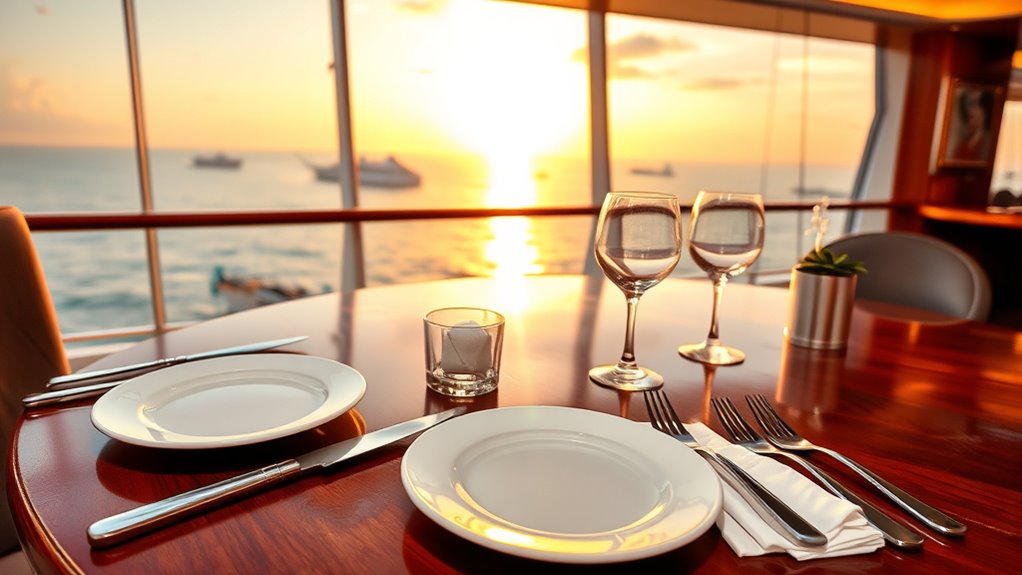
Understanding how much to tip during your cruise can help you avoid surprises and guarantee you show appreciation for good service. Most cruise lines recommend gratuities of $14–$20 per person daily, often automatically added as service charges or daily gratuities. Some lines include gratuity included in the fare, while others encourage pre-paying tips or tipping in cash at the end. For onboard expenses like bar drinks, spa treatments, or specialty dining, tipping usually ranges from 15% to 20% of the bill. Crew tips, such as for cabin stewards and dining staff, typically total around $80–$100 per person for a weeklong cruise. Planning your gratuities in advance helps you budget for these expenses and allows you to adjust for exceptional service or personalized attention.
Frequently Asked Questions
How Much Does It Cost for a 7 Day Cruise?
A 7-day cruise can cost you anywhere from $600 to over $4,000 per person, depending on your choice of cabin, itinerary, and cruise line. Inside cabins start around $400–$700, while balcony and suite options are more expensive. Remember, extra costs like tips, excursions, dining, and drinks can add up. Booking early, picking less popular dates, and looking for promotions help you save money on your trip.
How Much Does an Actual Cruise Ship Cost?
You might not realize it, but building a cruise ship is a massive financial endeavor. For a smaller vessel, you’re looking at around $500 million, while larger, state-of-the-art ships can easily surpass $1 billion. These investments include cutting-edge technology, luxurious amenities, and extensive engineering. With ongoing operating costs soaring over $250 million annually, it’s clear that cruise ships represent some of the most significant and complex investments in the travel industry.
What Is the Cheapest Month to Go on a Cruise?
If you’re wondering about the cheapest time to cruise, you’ll want to plan during shoulder seasons like May or September. During these months, demand drops, and cruise lines offer better deals. Caribbean cruises in May can be 20-30% cheaper, while Alaska and Mediterranean trips also see lower prices. Booking early or last-minute during these times can help you save even more, making your dream cruise more affordable.
How Much Does a Typical 4 Day Cruise Cost?
Ever wondered what you’ll spend on a 4-day cruise? Typically, it costs between $300 and $800 per person, depending on your cabin choice and destination. Inside cabins are more affordable, while balconies cost more. Remember to budget extra for gratuities, shore excursions, drinks, and travel to the port. Overall, plan for $500 to $1,200 per person, including fees and extras, to enjoy your cruise comfortably.
Conclusion
Ultimately, a cruise’s sticker price might seem simple, but the true cost dances beyond the initial fare—like hidden treasures waiting to be uncovered. While you’re tempted by luxurious upgrades or exciting excursions, don’t forget the small expenses—tips, drinks, or souvenirs—that turn your voyage into a memorable adventure. Balancing your budget is like steering through calm waters amid a storm—prepare well, and you’ll enjoy smooth sailing from start to finish.
Claire, a creative soul with an unquenchable thirst for storytelling, is an integral part of the Voyager Info team. As a dedicated writer, she weaves captivating narratives that transport readers to enchanting cruise destinations and beyond.
Claire’s love affair with writing began at an early age when she discovered the magic of words and their ability to craft worlds and emotions. Her innate curiosity led her to explore various literary genres, but it was travel writing that truly captured her heart. Drawing inspiration from her own globetrotting adventures and encounters with diverse cultures, Claire embarked on a journey to become a travel writer par excellence.

